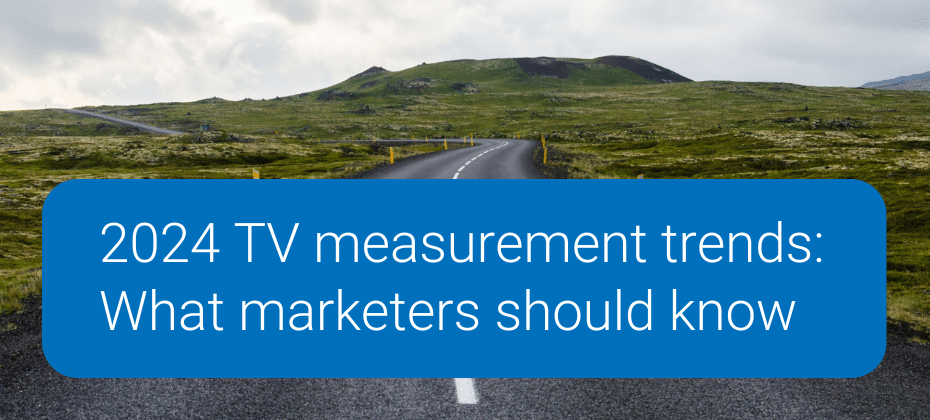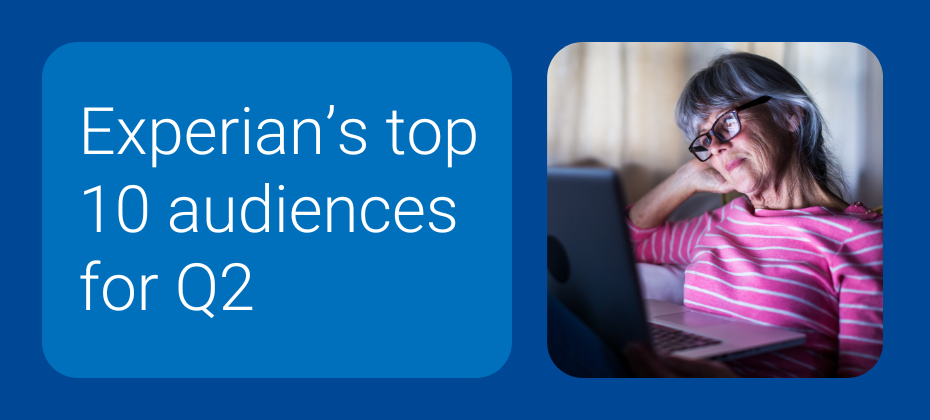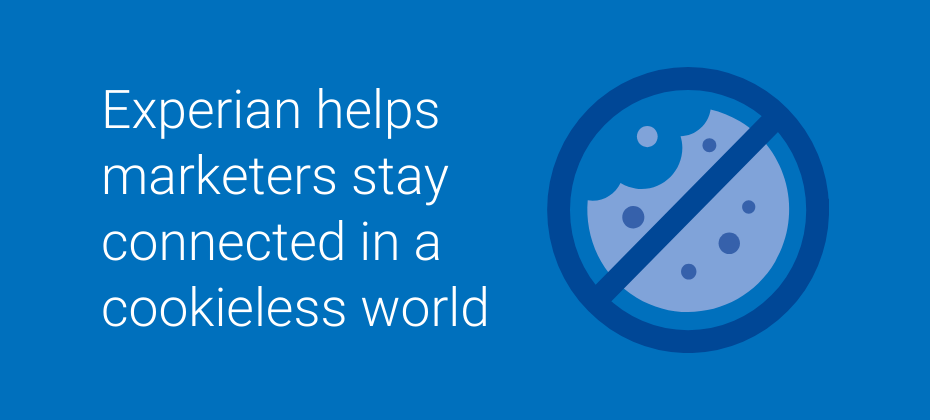Marketing trends
The latest insights on the shifts shaping advertising, media, and technology—all in one place. From emerging consumer behaviors to innovations in data, identity, and targeting, we cover the trends that matter most to marketers and advertisers. Whether you’re navigating seasonal campaigns, planning next quarter’s strategy, or exploring the future of retail media and programmatic, stay informed here.

With the back-to-school season approaching, marketers are preparing to engage both eager students and parents. Our Q&A video with Experian experts shares our predictions and tips for the 2024 back-to-school season so you can craft effective back-to-school marketing campaigns. From early campaign launches to the rise of online shopping and budget-conscious consumer behaviors, let’s explore what lies ahead and how brands and agencies can prepare. What separates Experian's syndicated audiences Experian’s 2,400+ syndicated audiences are available directly on over 30 leading television, social, programmatic advertising platforms, and directly within Audigent for activation within private marketplaces (PMPs). Reach consumers based on who they are, where they live, and their household makeup. Experian ranked #1 in accuracy by Truthset for key demographic attributes such as Presence of Children. Access to unique audiences through Experian’s Partner Audiences available on Experian’s data marketplace, within Audigent for activation in PMPs and directly on platforms like DirectTV, Dish, Magnite, OpenAP, and The Trade Desk. Watch the highlights from our video below. Three trends for the 2024 back-to-school marketing season Campaigns will start earlier We expect back-to-school marketing efforts to kick off earlier than usual. Brands will launch campaigns with special promotions to secure mind and market share ahead of competitors. Additionally, the traditional back-to-school season is extending, urging marketers to prolong their campaigns to capture the attention of consumers who are taking more time to make purchasing decisions. Online shopping will continue to rise The surge in online shopping during the pandemic has become a lasting trend – and is especially appreciated by busy parents seeking convenience. Brands should focus on enhancing online and mobile shopping experiences, including options for in-store pickup and delivery. Marketers should prioritize their online presence and optimize e-commerce platforms, including experimenting with shoppable ads on connected TV (CTV), to meet the needs of families shopping for back-to-school supplies. Budget consciousness is top of mind With inflation on the rise and tighter budgets at home, households are becoming more selective in their back-to-school spending. Marketers should align their efforts with value-driven products and prioritize advertising that resonates with these financial priorities. Strategies for brands and agencies Next, let's explore strategies brands and agencies can use to prepare for the upcoming back-to-school season. Brands First, we'll highlight three recommended strategies for brands. Maintain an evergreen presence Launch your back-to-school campaigns early and maintain a steady presence throughout the season. Experian's TrueTouchTM audience insights can guide your channel selection for maximum impact, helping you decide on key channels such as email, digital video, or specific social media platforms. Build loyalty programs that deepen customer relationships Use your customer data to create loyalty programs that foster stronger connections with your audience. By using insights from Experian, you can gain a holistic understanding of customer profiles and identify potential back-to-school prospects within your existing customer base. On average, Experian has 250 behavioral and demographic marketing attributes per individual, which means we can decorate households and people with marketing data to get a full customer profile and fill in any gaps you have on your audience. Prioritize value and convenience Offer flexible shopping options like in-store, online, and buy online, pick up in-store (BOPIS) to cater to busy families. Partner with services like Shipt or Instacart to streamline shopping experiences. Agencies Now, we'll share two ways agencies can effectively prepare for the back-to-school season. Engage early and extend your campaigns Initiate conversations with brands earlier to ensure timely planning and execution. Extend campaign durations to capture late-decision makers. Adapt your channel strategies Shift focus to digital channels like CTV and social media, aligning with evolving consumer habits and preferences. Experian works with major platforms, marketers, and agencies, which means we have existing partnerships across the ecosystem for you to connect with and bring your consumer data to life to meet your needs. Watch the full Q&A The 2024 back-to-school season promises new challenges and opportunities for marketers. By starting campaigns earlier, optimizing online experiences, and aligning with budget-conscious consumers, brands and agencies can position themselves for success. Watch our full Q&A video where our experts cover: Tactics we predict marketers will employ to navigate signal loss Which channels will be the most successful Recommended audiences for targeting And more! Watch now Need a custom audience? Reach out to our audience team and we can help you build and activate an Experian audience on the platform of your choice. Additionally, work with Experian’s network of data providers to build audiences and send to an Audigent PMP for activation. Contact us Latest posts

This summer’s games in Paris represent an extraordinary opportunity to connect with sports audiences on a global scale. As we anticipate this momentous event that happens once every four years, it’s clear that the passion and excitement surrounding sports are more vibrant than ever. With one billion viewers expected to tune in, now is the time to take advantage of the fervor of sports fans and tailor your strategies to resonate with this audience. In this blog post, we’ll explore audience segments that can maximize the impact of sports and influencer marketing campaigns, drawing inspiration from the anticipation of this summer’s games. What separates Experian's syndicated audiences Experian’s 2,400+ syndicated audiences are available directly on over 30 leading television, social, programmatic advertising platforms, and directly within Audigent for activation within private marketplaces (PMPs). Reach consumers based on who they are, where they live, and their household makeup. Experian ranked #1 in accuracy by Truthset for key demographic attributes. Access to unique audiences through Experian’s Partner Audiences available on Experian’s data marketplace, within Audigent for activation in PMPs and directly on platforms like DirectTV, Dish, Magnite, OpenAP, and The Trade Desk. What are the benefits of advertising in sports? Before we explore these audience segments, first let’s review three benefits of advertising in sports. Increase product awareness Sports viewers are less likely to skip commercials, so you can increase product awareness by reaching more engaged consumers. Reach current customers during sports games to remind them of your products and inspire more purchases. Build a strong connection with dedicated fans Fans exhibit unwavering loyalty to their teams, staying dedicated whether their team wins or loses. This loyalty is highly beneficial for brands, as loyal fans are not only enthusiastic spenders but also form lasting, meaningful connections with the brand. Improve audience targeting Live sports are now available to watch on many streaming services like Peacock and Amazon, allowing marketers to better choose and target audience segments across connected TV (CTV) to deploy more personalized ads – something that is limited with traditional TV sports broadcasting. When you work with Experian, you work with the #1 ranked data provider that gives you access to demographic and behavioral targeting that allows you to reach consumers based on who they are, where they live, and what they do. To fully take advantage of the benefits of sports advertising, here are the audience segments we recommend targeting to drive engagement and conversion. Sports fans Harnessing the enthusiasm of sports fans can drive powerful engagement and brand loyalty. Align your campaigns with major sporting events, teams, or athletes to tap into the emotional connection fans have with their favorite sports or countries. Here are 10 audience segments that you can activate to target sports fans: Likely to be a sports enthusiast: Lifestyle and Interests (Affinity) > Activities and Entertainment >MLB EnthusiastsNASCAR EnthusiastNBA EnthusiastsNFL EnthusiastsNHL Enthusiasts PGA Tour Enthusiasts Travels to see professional sports: Travel Intent > Activities > Professional Sports Event NEW! Pickleball enthusiast: Retail Shoppers: Purchase Based > Sporting Goods, Apparel > Pickleball Enthusiast NEW! Wilderness sports and camping enthusiasts: Retail Shoppers: Purchase Based > Outdoor Activities > Wilderness Sports and Camping Enthusiasts Worldview WorldView offers immediate access to essential demographic and consumer data using advanced satellite technology and machine learning. Marketers planning campaigns ahead of this summer’s games can use WorldView to understand their audience, optimize distribution, and identify untapped market areas across 90 countries. With WorldView, you can benchmark performance, visualize customer data, and create a consistent global audience strategy for digital activation. This comprehensive solution provides valuable insights for location planning, data enrichment, and targeted digital advertising, without relying on personal information, making it ideal for geo-targeted marketing approaches. Sporting events and travel beyond this summer’s games While this summer’s games are a major draw, there are still many sports fans who may prefer events that aren’t connected to the summer games during this time. You can pair our Travel Intent > Activities > Professional Sports Event audience with our Lifestyle and Interests (Affinity) > Sports and Recreation > Sports Enthusiast audience to target individuals who have expressed interest in attending sporting events or traveling for sports-related activities. We can deliver our syndicated audience segments to 30+ activation platforms, which means we have a solution however you want to consume and use our data. Sports spectators Enhancing the experience of sports spectators can create memorable moments and lasting impressions. Target individuals interested in attending sporting events, promote ticket sales, VIP experiences, and exclusive merchandise to elevate their game-day experience and foster a sense of belonging within the sports community. Here are 7 audience segments that you can activate to target sports spectators: Interested in sports: Lifestyle and Interests (Affinity) > Sports (FLA / Fair Lending Friendly)*Baseball (FLA / Fair Lending Friendly) Football (FLA / Fair Lending Friendly) Visits sports venues: Mobile Location Models > Visits >College Sport VenuesNFL Stadium VisitorsUniversity Stadium College Football Visitor MLB Stadium Visitors You can also develop targeted advertising campaigns promoting travel packages or hotel deals around Paris. Highlight proximity to this summer’s games, special experiences, or exclusive offers for travelers during this summer’s games season. By targeting specific travel preferences and behaviors, you can capture the attention of individuals planning trips around this summer’s games. When you work with Experian, you work with a single data provider that gives you access to audiences across multiple verticals and categories like travel and retail. Sporting goods shoppers You can use Experian audiences to reach consumers interested in sports and fitness ahead of the summer games. Targeting individuals in the market for sports equipment and apparel can help you reach those actively seeking sporting goods. By focusing on this segment, you can increase conversion rates and optimize ad spend by reaching an audience already inclined toward sports and fitness shopping. Here are 6 audience segments that you can activate to target consumers who are spending on sports apparel: NEW! Wears athleisure: Retail Shoppers: Purchase Based > Sporting Goods, Apparel > Athleisure Sportswear Apparel Women's activewear high spenders: Retail Shoppers: Purchase Based > Apparel > Women's Activewear / Yoga: Online High Spenders Men's activewear high spenders: Retail Shoppers: Purchase Based > Apparel > Men's Apparel (Clothing): Men's Activewear: High Spenders Athletic footwear high spenders: Retail Shoppers: Purchase Based > Apparel > Footwear (Shoes): Athletic Footwear: High Spenders Golf equipment frequent spenders: Retail Shoppers: Purchase Based > Sporting Goods, Apparel > Golf Equipment, Apparel, Entertainment Frequent Spenders Sporting goods shoppers: Mobile Location Models > Visits > Sporting Goods Shoppers Athletes For brands catering to athletes and sports enthusiasts, targeting active players is crucial. Offer products, training tips, and motivational content that inspire and empower them to excel in their chosen sports. Here are 5 audience segments that you can activate to target athletes: Likely to play sports: Lifestyle and Interests (Affinity) > Sports and RecreationPlays HockeyPlays Soccer Plays Tennis Likely to play golf: Lifestyle and Interests (Affinity) > Activities and Entertainment > Play Golf NEW! E-motion riders: Retail Shoppers: Purchase Based > Outdoor Activities > EMotion Riders E-Scooters E-Bikes E-Skateboards Influencer marketing campaigns Collaborate with influential athletes or sports personalities to create sponsored content that resonates with sports fans. You can pair our Social media heavy user audience with our Likely to be a sports enthusiast and TrueTouch conversion channel audiences to reach those who are likely to be influenced by endorsements from celebrities or athletes. Targeted advertising in sports with Experian audiences By using Experian's syndicated audiences in sports advertising, you can reach sporting goods shoppers, passionate sports fans, active players, and enthusiastic spectators. Our deep understanding of people in the offline and digital worlds provides you with a persistent linkage of personally identifiable information (PII) data and digital identifiers, ensuring you rich insights, accurate targeting across devices, improved addressability, and measurable advertising. Just as athletes strive for excellence, with the right approach, your advertising in sports initiatives will stand out as champions in the arena of consumer engagement. Can’t find the audience you’re looking for or need a custom audience? Connect with our audience team for more information. Additionally, work with Experian’s network of data providers to build audiences and send to an Audigent PMP for activation. Connect with our audience team You can activate our syndicated audiences on-the-shelf of most major platforms. For a full list of Experian's syndicated audiences and activation destinations, download our syndicated audiences guide. Check out other seasonal audiences you can activate today. View now Contact us Footnote * “Fair Lending Friendly” indicates data fields that Experian has made available without use of certain demographic attributes that may increase the likelihood of discriminatory practices prohibited by the Fair Housing Act (“FHA”) and Equal Credit Opportunity Act (“ECOA”). These excluded attributes include, but may not be limited to, race, color, religion, national origin, sex, marital status, age, disability, handicap, family status, ancestry, sexual orientation, unfavorable military discharge, and gender. Experian’s provision of Fair Lending Friendly indicators does not constitute legal advice or otherwise assures your compliance with the FHA, ECOA, or any other applicable laws. Clients should seek legal advice with respect to your use of data in connection with lending decisions or application and compliance with applicable laws. Latest posts

Explore how CTV is transforming political advertising for the 2024 elections, offering new opportunities for engagement for a digital-first approach.

In this article... In this article... In this blog post...What is political campaign marketing?Benefits of digital marketing in political campaignsExperian's political personasHow to combine our political personas with other audiences In the American political landscape, understanding the intricacies of voters' attitudes and behaviors has never been more crucial. With the 2024 election season on the horizon, the challenge lies in moving beyond broad categorizations like "Democrat," "Republican," or "Independent." Voters seek candidates who resonate with their beliefs and values. To meet this challenge, Experian has created political personas that offer a nuanced understanding of American voters. In this blog post, we’ll explore how these Experian audiences can help you tailor your engagement strategies for the upcoming election cycle. Before we dive into our political personas, let's break down what political campaign marketing is and six benefits of using digital marketing in political campaigns. What is political campaign marketing? Political campaign marketing is the strategic engine that drives candidates toward electoral success. It involves crafting and sending out tailored messages to effectively reach constituents to inform them about candidates’ stances on key issues. Think of it as the art of narrative construction, using various communication channels—from traditional media to digital platforms—to engage and mobilize supporters. In an era marked by information saturation, effective campaign marketing serves to cut through the noise to deliver compelling messages that inform, inspire, and spur action. Benefits of digital marketing in political campaigns As the 2024 election approaches, using digital marketing in political campaigns becomes paramount to effectively reach and influence voters where they spend a significant portion of their time—online. Kamala Harris's entry into the race has shifted spending priorities, particularly in critical states such as Ohio, where the Senate race has already attracted $300 million in ad spending. Political ad spend on connected TV (CTV) is expected to rise significantly, from 2.7% in 2020 to 12.8% this year. The Harris campaign is spearheading this trend, dedicating $200 million to digital ads, with a substantial portion directed toward streaming platforms. Embracing digital marketing can help campaigns effectively shape opinions and mobilize support. Here are five key benefits of integrating digital marketing strategies into political campaigns: Unparalleled reach with targeted advertising: A well-connected digital platform partner can help you reach your target audiences across the ecosystem – from social to the open web. Optimization flexibility: Digital marketing allows for quick adjustments in response to real-time data and evolving circumstances. Interactive engagement: The interactive nature of digital channels creates meaningful engagement and dialogue between candidates and voters, building connections and community. Insights: Robust analytics provide valuable insights into audience behavior and preferences, facilitating continuous optimization and refinement of outreach efforts. Amplified messaging: Through digital marketing, political campaigns can amplify their message, mobilize support, and forge deeper connections with voters. Data serves as the foundation for these benefits. Interactivity hinges on data to deliver the right message and creative for engagement. Insights are gained through pre-campaign research, analyzing audience attributes to grasp their interests and behaviors. Flexibility relies on real-time campaign data, a unique advantage in digital marketing. In an era where audiences are available readily on most major activation platforms, advertisers need to understand how audiences are built to be privacy conscious and consistent in a cookieless environment. Experian’s political personas Digital marketing in political campaigns is crucial to reach and influence voters online. Integrating Experian's political personas into your political campaign strategy can help you grasp the complexities of today's American voter landscape and craft tailored engagement strategies. These personas offer invaluable insights into voter viewpoints on key political issues, enriching digital marketing efforts and empowering campaigns to connect with constituents more effectively. Experian has created 10 political personas to help you better understand today’s American voter so you can reach consumers based on their viewpoints into key political issues. Our political personas group voters along the political spectrum from most “committed” on the ends of the spectrum. Let’s walk through how we define each persona starting from the most “committed” personas on the ends of the spectrum. Committed Democrats This audience contains consumers who are likely to have a "very liberal” outlook on political issues. They have strong liberal opinions on various topics including key issues and the economy and are very involved in their communities. Committed Republicans This audience contains consumers who are likely to have a "very conservative” outlook on political issues. They are well-informed, community-minded individuals with strong opinions that reflect their conservatism. They have very conservative attitudes regarding key social issues. Moderate Democrats This audience contains consumers who are likely to have a “somewhat liberal” outlook on political issues. Moderate Republicans This audience contains consumers who are likely to have a “somewhat conservative” outlook on political issues. Political Leaning Liberals This audience contains consumers who are likely to have strong opinions on key issues that may not align with the traditional Democrat point of view. Political Leaning Conservatives This audience contains consumers who are likely on-the-fence on traditional Republican points of view on key issues. Liberal Leaning Independents This audience contains consumers who are registered independents and who are likely to have a “middle of the road” outlook on political issues while tending to lean more liberal. Conservative Leaning Independents This audience contains consumers who are likely registered independents and likely have a "middle-of-the-road” outlook on political issues while tending to lean more conservative. Political Unregistered Liberal Leaning This audience contains consumers who are not likely to have aligned with a specific party, but have a more liberal attitude. They are well-informed and are aware of important political issues. They frequently align with but are not necessarily completely aligned with liberal points of view. Political Unregistered Conservative Leaning This audience contains consumers who are not likely to have aligned with a specific party, but have a more conservative attitude. They are well-informed and are aware of important political issues. They frequently align with but are not necessarily completely aligned with conservative points of view. These 10 personas can help you better understand who the American voter is, but when combined with our 200 politically relevant audiences, such as watches political TV, donations to charitable causes, engagement channel preferences, hobbies, and more, the ability to study and improve engagement for each persona is considerably magnified. How to combine our political personas with other audiences If you're a political candidate looking to reach an important population, Experian audiences are available on-the-shelf of major platforms. For example, if you want to reach unregistered voters and independent voters to influence green initiatives within your community, you can focus on unregistered and moderate personas in the area and combine that with audiences interested in green initiatives, like our GreenAware segments – which predict a consumer’s attitude and point of view on environmental issues. You can use our "Political Unregistered Liberal Leaning", "Liberal Leaning Independents," and GreenAware “Think Greens” audience segments to reach constituents who are likely to be most interested in your message. To reach voters based on their regional voting patterns, you can use our new battleground counties and district audiences: Affiliation Switcher Counties Battleground Counties House Battleground Districts Democrat Counties Republican Counties Independent Counties Add Experian’s audiences to your 2024 election strategy Political advertising spend is projected to surpass $12 billlion in the 2024 election cycle, generating the largest amount of voter outreach in the history of American elections. Experian’s audiences are available on major activation platforms allowing you to strategically reach constituents who would be most impacted and interested in your initiatives. As we approach a cookieless future, Experian’s political personas are cookie resilient. Our data is rooted in both offline and online data that doesn’t rely on third-party cookies. The personas do not rely on an individual’s browsing behavior. Experian can help our partners understand and engage with these political audiences. Over 200 politically relevant Experian audiences are available for activation on-the-shelf of the leading TV, demand, and supply platforms. Here are the platforms where you can find our political audiences: ArcSpan Audigent Cadent Eyeota Magnite Microsoft Nexxen Pandora Permutive Samsung Ads The Trade Desk Verizon Media Viant Videoamp Yieldmo Can’t find the audience you’re looking for or need a custom audience? Connect with our audience team for more information. Connect with our audience team Contact us Latest posts

Explore the future of TV measurement with Experian Marketing Services. Stay ahead in 2024 with the latest trends and data insights.

At Experian, we understand the critical role that audience targeting plays in the success of marketing campaigns. That's why we're excited to share this curated list, aimed at helping agencies and media buyers plan their campaigns and effectively reach their audiences with precision and confidence. What separates Experian's syndicated audiences Experian’s 2,400+ syndicated audiences are available directly on over 30 leading television, social, programmatic advertising platforms, and directly within Audigent for activation within private marketplaces (PMPs). Reach consumers based on who they are, where they live, and their household makeup. Experian ranked #1 in accuracy by Truthset for key demographic attributes. Access to unique audiences through Experian’s Partner Audiences available on Experian’s data marketplace, within Audigent for activation in PMPs and directly on platforms like DirectTV, Dish, Magnite, OpenAP, and The Trade Desk. Here's a look at the Experian audiences that were the most popular in Q2 2023. Which ones will you add to your Q2 campaign planning? Our top 10 audiences for Q2 Fitness enthusiast Lifestyle and Interests (Affinity) > Health & Fitness > Fitness Enthusiast In-store high spender on baby products Retail Shoppers: Purchase Based > Shopping Behavior > Baby Products: In Store High Spenders Has a bachelor’s degree Demographics > Education > Bachelor Degree In-market for an SUV and CUV Autos, Cars and Trucks > In Market-Body Styles > SUV and CUV In-market for a mid-size truck Autos, Cars and Trucks > In Market-Body Styles > Mid-Size Truck Homeowner Demographics > Homeowners/Renters > Homeowner In-market for a small, mid-size SUV Autos, Cars and Trucks > In Market-Body Styles > Small Mid-Size SUV In-market for a full-size truck Autos, Cars and Trucks > In Market-Body Styles > Full-Size Trucks In-market for a full-size SUV Autos, Cars and Trucks > In Market-Body Styles > Full-Size SUVs Household income level Demographics > Household Income (HHI) > $75,000+ Our top 5 audiences by vertical Which audience segments were the most popular by advertiser vertical? Advanced TV Household income level Demographics > Household Income (HHI) > $75,000-$99,999 Interested in dogs Lifestyle and Interests (Affinity) > Pets > Dogs (FLA / Fair Lending Friendly)1 Homeowner Demographics > Homeowner/Renter > Homeowner Household income level Demographics > Household Income (HHI) > $100,000-$124,999 Interested in arts and entertainment Lifestyle and Interests (Affinity) > Art and Entertainment > Visual Art and Design (FLA / Fair Lending Friendly) Agency Dog owner Lifestyle And Interests (Affinity) > Pets > Dog Owners Cat owner Lifestyle And Interests (Affinity) > Pets > Cat Owners Active investor Lifestyle And Interests (Affinity) > Investors > Active Investor Mutual fund investor Lifestyle And Interests (Affinity) > Investors > Mutual Fund Investor In-market for a full-size SUV Autos, Cars and Trucks > In Market-Body Styles > Full-Size SUVs Auto In-market for a new car Autos, Cars and Trucks > In Market-New/Used > New Car In-market for a used car Autos, Cars and Trucks > In Market-New/Used > Buyer Used In-market for a Honda Autos, Cars And Trucks > In Market-Make And Models > Honda In-market for an auto loan Financial FLA Friendly > In Market Auto Loan In-market for an auto lease Financial FLA Friendly > In Market Auto Lease Did you know? Consumers looking to buy a new vehicle prefer streaming TV, digital newspapers, and email for communication2. By merging our TrueTouchTM engagement channel audiences with our Auto in-market audiences, you can effectively target these consumers through their preferred channels. TrueTouch facilitates personalized advertising campaigns by predicting consumer preferences, ensuring messaging styles align with the right channels and calls to action. By understanding what types of media people prefer, you can match the best way to talk to them with what to offer, using the right channels for personalized ads. No consumer is the same – and you need to engage with them on their terms to successfully market to them. Financial Active in the military Lifestyle And Interests (Affinity) > Occupation > Military – Active In-market for a credit union loan Financial FLA Friendly > In Market Credit Union Loan 40-49 years old Demographics > Ages > 40-49 30-39 years old Demographics > Ages > 30-39 Small business owner Consumer Behaviors > Occupation: Small Business Owners Health 25-29 years old Demographics > Ages > 25-29 30-34 years old Demographics > Ages > 30-34 Weight conscious Lifestyle and Interests (Affinity) > Health & Fitness > Weight Conscious Moms interested in fitness Lifestyle and Interests (Affinity) > Moms, Parents, Families > Fitness Mothers High spenders at vitamin/supplement stores Retail Shoppers: Purchase Based > Health and Fitness > Vitamins/Supplements: Vitamins/Supplements Retail & CPG Dog owners Lifestyle And Interests (Affinity) > Pets > Dog Owners Cat owners Lifestyle And Interests (Affinity) > Pets > Cat Owners Fitness enthusiast Lifestyle and Interests (Affinity) > Health & Fitness > Fitness Enthusiast Interested in healthy living Lifestyle and Interests (Affinity) > Health & Fitness > Healthy Living High spenders at vitamin/supplement stores Retail Shoppers: Purchase Based > Health and Fitness > Vitamins/Supplements: Vitamins/Supplements Activate the right audiences with Experian When you choose Experian’s syndicated audiences, you gain access to over 2,400 audiences that span across 15 verticals and categories. These audiences are directly available for activation on over 30 platforms and can be sent to over 200 media platforms. Experian is ranked #1 for data accuracy (as validated by Truthset) and Experian Marketing Data is the foundation for successful targeting, enrichment, and activation. For a full list of Experian's syndicated audiences and activation destinations, download our syndicated audiences guide. Need a custom audience? We can help you build and activate an Experian audience on the platform of your choice. Connect with our audience team Check out other seasonal audiences you can activate today. Contact us Footnotes Fair Lending Act Friendly audiences: “Fair Lending Friendly” indicates data fields that Experian has made available without use of certain demographic attributes that may increase the likelihood of discriminatory practices prohibited by the Fair Housing Act (“FHA”) and Equal Credit Opportunity Act (“ECOA”). These excluded attributes include, but may not be limited to, race, color, religion, national origin, sex, marital status, age, disability, handicap, family status, ancestry, sexual orientation, unfavorable military discharge, and gender. Experian’s provision of Fair Lending Friendly indicators does not constitute legal advice or otherwise assure your compliance with the FHA, ECOA, or any other applicable laws. Clients should seek legal advice with respect to your use of data in connection with lending decisions or application and compliance with applicable laws. Experian looked at our Auto and TrueTouch audience data to understand media preference trends over the past year. Latest posts

With the impending deprecation of third-party cookies, marketers find themselves at the crossroads of innovation and adaptation. As we bid farewell to this identifier, the emphasis shifts to forging deeper connections, understanding customer needs, and navigating the marketing landscape with data-driven precision. At Experian, we stand as your trusted partner, committed to guiding you through this transition. In this blog post, we'll explore: How third-party cookie deprecation is impacting digital advertising Six alternatives to third-party cookies and where they fall short How Experian can help you navigate a cookieless world Four ways third-party cookie deprecation is impacting digital advertising Third-party cookie deprecation is causing significant challenges within the AdTech industry, manifesting in four key areas: Reach: Advertisers and demand-side platforms (DSPs) will face difficulties in reaching their target customers due to the absence of third-party cookies. Understanding audiences: Advertisers will find it challenging to understand the demographics and behaviors of their customer base without third-party cookies. Similarly, publishers are struggling to identify their audiences accurately, resulting in less addressable and appealing inventory. Measurement: Measurement providers may encounter obstacles in accurately assessing the effectiveness of advertising campaigns. Additionally, DSPs are finding it hard to measure the impact of their ads without the assistance of third-party cookies. Matching: Data providers may experience challenges in matching users with the appropriate audience segments, leading to difficulties in delivering targeted advertising. Six alternatives to third-party cookies As the deadline approaches for Google's removal of third-party cookies from Chrome by the end of 2024, marketers are scrambling to discover alternative methods for delivering effective advertising. Fortunately, various alternatives are emerging. However, the abundance of options can create confusion rather than clarity. Which alternatives are worth considering? Here are six compelling alternatives to third-party cookies: 1. First-party data Acquiring consented first-party data directly from users is becoming increasingly vital as it can lay the groundwork for more precise targeting. 2. Universal IDs Alternative identifiers like The Trade Desk's UID2 and ID5’s Universal ID are becoming increasingly important, offering the ability to maintain a comprehensive consumer view across channels and platforms, leading to enhanced personalization and addressability across various channels, even in cookieless environments. 3. Identity graphs As browser-based IDs shift and digital signals decline, the need for an identity graph grows, with companies adopting a "graph-of-graph" strategy by combining their own robust first-party data with licensed identity graphs, as highlighted in recent announcements by industry giants such as Disney, VideoAmp, and Magnite. 4. Contextual targeting Contextual targeting aligns publisher content with relevant ads, ensuring ad delivery based on content rather than individual identifiers. This privacy-respecting approach is less dependent on third-party cookies, providing effective audience activation. 5. Data collaboration In a cookieless world, it becomes more difficult for companies to "communicate" with one another. We expect to see more pick up of data collaboration in the market, using addressable IDs and identity resolution to power connectivity between partners and their data sets. 6. Google Privacy Sandbox The primary goal of Google’s Privacy Sandbox is to continue to deliver valuable consumer information that yields relevant marketing and media strategies, while protecting a user’s privacy. How these alternatives to cookies fall short While it's promising to see numerous alternatives to cookies emerging, it's essential to recognize that each alternative has its limitations and is not a perfect one-to-one replacement for third-party cookies. Let’s review the shortcomings of these alternatives, and then we’ll walk through how Experian can help you navigate these alternatives to cookies. 1. First-party data First-party data, which is data directly collected from your users with their consent, is highly valuable. However, you will likely face limitations in terms of the number of consumers in your database, the identifiers linking them, and the insights into their demographics and behaviors. To overcome these limitations, it's essential to expand both the quantity and quality of your first-party data. 2. Universal IDs Universal identifiers are valuable for tracking users across different devices and websites. However, no single universal identifier has enough reach to fully replace third-party cookies. Universal IDs are most effective in terms of scaling, when they are combined with other universal identifiers or alternative addressable identifiers. 3. Identity graph Identity graphs excel at connecting digital audiences. However, establishing an identity graph from scratch is a significant accomplishment, demanding expertise, financial resources, and more. 4. Contextual targeting Contextual targeting and advertising aim to place your ads next to relevant content. However, there's a risk that your ads might appear alongside misaligned content, reaching audiences who are uninterested or unintended. 5. Data collaboration Data collaboration is beneficial for enhancing your consumer data and informing your strategies. However, it can introduce potential data security risks, if not done in the right framework, and may lead to subpar matching results due to issues like data hygiene or discrepancies in identifiers. 6. Google Privacy Sandbox Google’s Privacy Sandbox aims to balance effective advertising with consumer privacy and data security. However, it lacks transparency and has yet to prove its effectiveness, raising concerns about whether it meets industry standards. How Experian can help you navigate a cookieless world As an industry innovator and leader in data and identity, we've developed solutions to address the challenges posed by the shift away from third-party cookies. Our products are designed to adapt to these changes and ensure your success. We've anticipated industry shifts and proactively prepared our offerings to support you through this transition. Below we outline how our products are ready to support you through the transition away from third-party cookies. Graph The Experian Graph facilitates connectivity without relying on cookies. Our Graph helps ensure connectivity by supporting a variety of addressable identifiers, not limited to but including universal IDs, like Unified ID 2.0 (UID2) and ID5's universal ID. Whether you have first-party data or not, our Graph can be used to expand the reach of your first-party data or provide you with access to the full scope of our Graph's 126 million households and 250 million individuals. Activity Feed Supported by our Graph, Activity Feed can help you deliver digital connectivity and resolution in a cookieless environment. Activity Feed can resolve disparate activity to a single, consumer profile. It can expand the quantity of addressable identifiers associated with your first-party consumers. Additionally, Activity Feed, by joining disparate activity and identifiers, provides clearer insights, more addressable targets, and more holistic measurement. Our Marketing Attributes and Audiences In a cookieless environment, our Marketing Attributes and Audiences provide valuable information and insights about who your consumers are, like their demographics, shopping patterns, and more, to facilitate more informed decision-making. You can use our Marketing Attributes and Audiences to enrich your first-party data, giving you crucial insights into your customers so you can make informed, strategic decisions. They can be matched to universal identifiers, expanding their utility. Additionally, our Marketing Attributes and Audiences are sourced from non-cookie dependent offline and digital sources, ensuring they are unimpacted by third-party cookie deprecation. Collaboration While third-party cookies have primarily served to connect data in the industry, many companies are turning to data collaboration in lieu of having third-party cookies. In doing so, they can connect data with key partners, which they can use to make better media decisions. Experian Collaboration helps make data collaborations better, powering higher match rates by using the various identifiers supported in our offline and digital graphs. Through our current support of collaboration in three environments, within Experian, through crosswalks, and in clean rooms, such as AWS, InfoSum, and Snowflake, we ensure that you only share the data you intend to share, while the sensitive information remains secure. This way, your partner and you can focus on how to use the data to benefit you and not on anything else. Get started with alternatives to third-party cookies today While many view the deprecation of third-party cookies as disruptive, we see it as an opportunity for the industry to embrace a new era of advertising while prioritizing consumer privacy. Achieving this balance is crucial, and Experian's solutions are here to help you navigate it effectively. As the AdTech industry gravitates toward a few tactics to effectively advertise in the cookieless future, Experian is here to understand your core needs and recommend products that will help. In a rapidly evolving marketing landscape, Experian stands as your trusted partner, offering expertise in data-driven and identity solutions. Connect with our team to seamlessly transition into these alternatives to third-party cookies, ensuring your marketing strategies remain effective, privacy-compliant, and focused on meaningful connections. Get started today Latest posts

Shoptalk 2024, the premier event for retail and e-commerce professionals, brought together industry leaders to discuss the latest trends and innovations shaping the future of retail. As the retail landscape continues to evolve, here are four key takeaways from Shoptalk 2024: 1. The continuing rise of retail media networks The evolution of retail media is propelling us into a new era of advertising and first-party data monetization. Retailers are using their valuable first-party data to offer targeted advertising opportunities on both their owned and operated channels -- from sponsored content to personalized ads -- and through offsite programmatic ads. However, the full potential of retail media networks (RMNs) is hindered by challenges in understanding and targeting shoppers beyond retail data, reaching customers across channels and validating measurement. To unlock the true value of RMNs, and turn these challenges into opportunities, companies should focus on four areas: Gain insights: Learn more about your customers and the customers your marketing partners care about. Create audiences: Use enriched data to build addressable audience segments for advertisers to target. Maximize reach: Expand your addressability and monetize your data on and off platform. Demonstrate success: Validate marketing impact by connecting ad exposures to outcomes. “It was evident at Shoptalk 2024 that the rise of retail media is unstoppable. The conversations, collaborations, and insights shared at the event cemented the position of retail media networks as the driving force behind the future of commerce.”Alison Hofelich, Sr. Account Executive, Big Box Retail & Grocery 2. Content-led commerce Content is becoming increasingly pivotal in driving commerce, with retailers investing in shoppable video to stimulate conversations and foster customer engagement. While video may not always lead to immediate transactions, it can start dialogues, offering retailers a platform to enhance customer loyalty and influence future sales. Retailers talked about their focus on connecting with Gen Z on a deeper level. PacSun highlighted initiatives like the launch of a gender-fluid line and continuous engagement with young consumers via social media for feedback. Additionally, PacSun talked about embracing "conscious capitalism" by co-creating with influencers and customers, recognizing the growing consumer preference for brands that make a positive impact. By collaborating with influencers and using user-generated content, retailers can create authentic experiences that resonate with their customers. 3. Data privacy and trust With data playing a central role in retail strategies, ensuring data privacy, and building trust with consumers are imperative. Retailers must prioritize transparency and security to safeguard customer information and nurture long-term relationships. While the focus may currently be on capturing Gen Z market share, businesses need to anticipate shifts in consumer demographics and adapt their strategies accordingly. Using customer data in a privacy-compliant way enables retailers to implement effective personalization strategies that drive long-term engagement and loyalty. “Retail media networks were at the center of Shoptalk 2024. In addition to retail media networks, the seamless integration of data to enhance customer personalization and the rising importance of targeting Gen Z were recurring themes."Kai Rood, Account Executive, Retail Apparel 4. The time to embrace AI is now Technology continues to drive innovation in retail, with advancements in AI reshaping the shopping experience. From virtual try-ons to personalized product recommendations, retailers are using AI to engage consumers and enhance product discovery. Testing and learning are essential for AI implementation, as companies navigate the risks and rewards of technological innovation. Navigate the future of retail with Experian Shoptalk 2024 provided invaluable insights into the future of retail, highlighting the importance of retail media networks, content-led commerce, data privacy, and tech innovation. By embracing these trends and innovations, retailers can position themselves for success in an ever-evolving marketplace. At Experian, our solutions are tailored to empower businesses in navigating this dynamic landscape. Through our Consumer Sync solutions, we bridge the gap between online and in-store touchpoints, ensuring a unified strategy for reaching audiences across channels and evaluating campaign performance. Our Consumer View solutions enable you to tap into 5,000 demographic and behavioral attributes to fill in any gaps on your customer. Go beyond category buyers by combining your first-party data and Experian's top ranked data to build custom audiences that lead to higher ROI for your advertisers. Connect with a member of our team today to get started. Latest posts

Explore the impact of cookie deprecation on digital marketing and learn strategies to adapt using ethical data practices and first-party data.